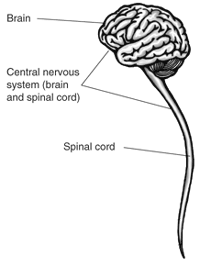
In the Wizard of Oz, Scarecrow wanted so badly to have a brain instead of his head filled with stuffin’. He wanted a brain he could use for thinkin’ of stuff he never “thunk” before.
In the second half of 2020, I took a certificate program in Neuroscience from The Neuroscience School near Montreal as continuing education for my International Coaching Federation (ICF) credential I maintain as a professional certified coach (PCC).
As crazy as it sounds, I’ve decided to create a podcast episode and blog post each month this year focused on some of the learnings from that Neuroscience program. Since I’m not an expert in Neurosciences, I’ll be drawing heavily from Dr. Irena O’Brien’s excellent certificate program, as well as other resources to make connections to leadership and life. If you haven’t had a chance to listen to the complementary podcast episode, you can catch it here.
The Brain
The human brain remains a type of frontier in science despite significant progress in our understanding of the body. The neurosciences have become a vast system of study that include fields like Affective Neuroscience relating largely to emotions, Clinical Neuroscience relating largely to nervous system disorders, and Social Neuroscience which is an interdisciplinary field relating largely to social processes and behavior—to name only a few of the many fields with the Neurosciences.
The Neurosciences have made enormous progress in studying autistic spectrum disorders, epilepsy, effects of stroke, ADHD, addiction, schizophrenia, Parkinson’s disease, brain tumors, and immune system disorders.
This blog on leadership and life is not the place, nor am I the person to try to explain the human brain’s anatomy. So alongside what a layman like me might call the medical aspects of the brain, I’m interested in a few key learnings for leaders to be able to apply to life in general.
This year, future podcast episodes and blog posts in Leadership Meets Life will focus on applications like decision-making, motivation, problem-solving, flow, stress, and the gut-brain connection. For now, let’s look at the overall nervous systems that interface in and with the brain.
The image below gives one of many views of how the brain is currently understood, in this case showing the basics of human functions like vision, hearing, and the body’s sensing capability.
Blausen.com staff (2014). "Medical gallery of Blausen Medical 2014". WikiJournal of Medicine 1 (2). DOI:10.15347/wjm/2014.010. ISSN 2002-4436.
Main Nervous Systems
Obviously, the brain doesn’t function in isolation. On the contrary, the brain relies on the spinal cord and an elaborate network of systems. The body’s nervous system has two main parts: the central nervous system and the peripheral nervous system. (Peripheral means the outlying parts of the body, the periphery.)
The two primary organs of the central nervous system are the brain and spinal cord, as shown below.

The other main part of the nervous system is the peripheral nervous system, comprised of nerves that branch off the spinal cord that runs down the spinal column from neck to lower back, connected along the way with nerves in the peripheral system that extends throughout the body, sending information to and from body organs based on information from the body organs and external stimuli, including sight, hearing, touch, smell, and taste.
under the Creative Commons Attribution-Share Alike 3.0 Unported license.
Information flowing along this central and peripheral highway network travels in both directions. Ascending, or afferent, nerve swathes “carry sensory information from the body to the brain.” Descending, or efferent, nerve swathes “send information pertaining to motor function from the brain to the rest of the body” (O’Brien).
Hang on, the next part gets a little complicated, but it will help set up future Leadership Meets Life podcast and blog learnings
Sub-Systems Within the Nervous Systems
Breaking down the nervous systems even further, the peripheral nervous system (in contrast to the central nervous system—brain and spinal cord) is divided into three subsystems:
- Somatic – from the Greek soma for body
- Autonomic – from two Greek words meaning self-governing (think, automatic)
- Enteric – from the Greek word for intestines
But wait, there’s more! You’re beginning to see why Scarecrow’s big ask of the Wizard was a tall order.
Somatic
The first subsystem (of three) of the peripheral nervous system is the somatic nervous system controls skeletal muscle and external sensory organs like the skin. The somatic system is considered voluntary because “the responses can be controlled consciously. Reflex reactions of skeletal muscle, however, are the exception. These are considered involuntary reactions to external stimuli” (O’Brien).
Autonomic
The second subsystem of the peripheral nervous system is the autonomic nervous system. This controls the body’s “automatic” functions that we aren’t consciously directing, like breathing, heartbeat, and digestive processes. The autonomic system is considered involuntary since we don’t consciously control it. This “auto” subsystem is divided even further (sorry!) into sympathetic and parasympathetic branches.
“The sympathetic nervous system is often considered the 'fight or flight' system while the parasympathetic nervous system is often considered the ‘rest and digest’ or ‘feed and breed’ system. In many cases, both … systems have ‘opposite’ actions where one system activates a physiological response and the other inhibits it” (O’Brien).
Nerves of the sympathetic division speed up heart rate, dilate pupils and relax the bladder. Whereas nerves of the parasympathetic division control functions, including reducing heart rate, constricting pupils, and contracting the bladder. The interplay of these two divisions of the autonomic nervous systems controls the stress response.
We’ll explore this in future blog posts as managing stress is a huge part of leadership and life.
When these interdependent sympathetic and parasympathetic branches are in balance, this balance is called homeostasis (literally, “standing still”). The notion of homeostasis is often used in change management or leadership when we refer to a planned or unplanned change that upsets the system’s equilibrium, taking the system out of its normal state, that is, the disruption of homeostasis.
Enteric
The third—and to me, most interesting—subsystem of the peripheral nervous system is the enteric nervous system and is embedded in the lining of the gastrointestinal system. This part of the nervous system not only governs the function of the gastrointestinal system but is referred to as separate from the autonomic nervous system because it has its independent reflex activity.
Although the enteric nervous system communicates typically with the central nervous system, it is often “described as a ‘second brain’ for several reasons…. [It] can operate autonomously…. [It] includes efferent neurons (from the brain), afferent neurons (to the brain), and interneurons, all of which make the enteric nervous system capable of carrying reflexes and acting as an integrating centre without [central nervous system] input” (O’Brien). We’ll look at the gut-brain connection in future posts and podcast episodes.
WHEW!
Ok, that’s probably more than you wanted to know about the brain and its related nervous systems. But it’s essential to have a base as we discuss the many associated themes in the months ahead, like:
- why it’s necessary to get enough sleep,
- why exercise plays such a huge role in brain health,
- staying focused and overcoming distractions
- how breathing, meditation and prayer play foundational roles in our overall wellbeing
So here’s a simple summary:
Central Nervous System
- Brain
- Spinal Cord
Peripheral Nervous System
- Nerves, throughout the body, are further divided into three subsystems:
- Somatic – controls skeletal muscles and external sensory such as the skin
- Autonomic – bodily functions not consciously directed, like breathing
- Sympathetic – fight/flight/freeze response
- Parasympathetic – rest/digest; feed/breed
- Enteric – controls digestive functions; communicates with central nervous system but can also operate autonomously (second brain)
See the diagram in the Resources section below for a more detailed summary.
It’s Personal
I have three reasons for tackling this neuroscience project in my 2022 Leadership Meets Life podcasts and blog:
3. I believe there are enormous neuroscience applications to leadership that are otherwise buried in books many leaders may not have time to read.
2. Preparing my podcast episodes and writing blog posts is the best way I know to embed my initial learning phase into a more lasting integration in my own understanding.
1. By putting myself “out there” with this neuroscience series, I’m creating accountability to put into practice—in my own leadership life—the many important learnings I’ll be sharing with you.
It’s a vulnerable and scary journey for me, and I’m excited you’re traveling with me!


Next month’s podcast and blog will focus on neuroplasticity and your leadership brain. It’s a fascinating topic.

- The Neuroscience School, led by Dr. Irena O’Brien
- Seven and A Half Lessons About the Brain by Lisa Feldman Barrett
- If I Only Had a Brain – Wizard of Oz Scarecrow Video Clip
- Brain Image via Wikimedia Commons
- Central Nervous System Image via Wikimedia Commons
- Nervous System Diagram via Wikimedia Commons.
Let me know how you’re connecting with the Leadership Meets Life Blog and Podcast. I’d love to hear from you! You can reach me directly at philb@designgroupintl.com or by visiting my website.
/Philip%20C.%20Bergey%20Headshot%20(300x300).png)
January 25, 2022
.png?width=525&name=Blausen_0102_Brain_Motor%26Sensory_(flipped).png)

.png?width=100&name=Phil%20Bergey%20Headshot%20(1).png)





Comments